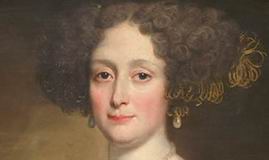The Marquise de BRINVILLIERS

Classification: Murderer
Characteristics: Poisoned 50 hospital patients as "practice" for profit-motivated murders of her father, brothers, and lover
Number of victims: 54 +/-
Date of murders: 1664 - 1673
Date of arrest: March 25, 1676
Date of birth: July 22, 1630
Victims profile: Hospital patients / Her father, brothers, and lover
Method of murder: Poisoning
Location: Paris, France
Status: She was beheaded and her body burned in Paris on the 16th of July 1676
BRINVILLIERS, MARIE MADELEINE MARGUERITE D'AUBRAY, MARQUISE DE (c. 1630-1676), French poisoner, daughter of Dreux d'Aubray, civil lieutenant of Paris, was born in Paris about 1630.
In 1651 she married the marquis de Brinvilliers, then serving in the regiment of Normandy. Contemporary evidence describes the marquise at this time as a pretty and much-courted little woman, with a fascinating air of childlike innocence.
In 1659 her husband introduced her to his friend Godin de Sainte-Croix, a handsome young cavalry officer of extravagant tastes and bad reputation, whose mistress she became. Their relations soon created a public scandal, and as the marquis de Brinvilliers, who had left France to avoid his creditors, made no effort to terminate them, M. d'Aubray secured the arrest of Sainte-Croix on a lettre de cachet.
For a year Sainte-Croix remained a prisoner in the Bastille, where he is popularly supposed to have acquired a knowledge of poisons from his fellow-prisoner, the Italian poisoner Exili. When he left the Bastille, he plotted with his willing mistress his revenge upon her father. She cheerfully undertook to experiment with the poisons which Sainte-Croix, possibly with the help of a chemist, Christopher Glaser, prepared, and found subjects ready to hand in the poor who sought her charity, and the sick whom she visited in the hospitals.
Meanwhile Sainte-Croix, completely ruined financially, enlarged his original idea, and determined that not only M. Dreux d'Aubray but also the latter's two sons and other daughter should be poisoned, so that the marquise de Brinvilliers and himself might come into possession of the large family fortune.
In February 1666, satisfied with the efficiency of Sainte-Croix's preparations and with the ease with which they could be administered without detection, the marquise poisoned her father, and in 1670, with the connivance of their valet La Chaussée, her two brothers.
A post-mortem examination suggested the real cause of death, but no suspicion was directed to the murderers. Before any attempt could be made on the life of Mlle Théresè d'Aubray, Sainte-Croix suddenly died. As he left no heirs the police were called in, and discovered among his belongings documents seriously incriminating the marquise and La Chaussée.
The latter was arrested, tortured into a complete confession, and broken alive on the wheel (1673), but the marquise escaped, taking refuge first probably in England, then in Germany, and finally in a convent at Liége, whence she was decoyed by a police emissary disguised as a priest.
A full account of her life and crimes was found among her papers. Her attempt to commit suicide was frustrated, and she was taken to Paris, where she was beheaded and her body burned on the 16th of July 1676.
1911 Encyclopædia Britannica
Marie-Madeleine-Marguerite d'Aubray, Marquise de Brinvilliers (22 July 1630 – 17 July 1676) was a French serial killer.
Crimes
Marie-Madeleine-Marguerite d'Aubray conspired with her lover, army captain Godin de Sainte-Croix to poison her father Antonine Dreux d'Aubray in 1666 and two of her brothers, Antoine d'Aubray and François d'Aubray, in 1670, in order to inherit their estates. There were also rumors that she had poisoned poor people during her visits to hospitals.
She appears to have used Tofana poison, whose recipe she seems to have learned from her lover, the Chevalier de Sainte Croix, who had learned it from Exili, an Italian poisoner, who had been his cellmate in the Bastille. Her accomplice Sainte-Croix had died of natural causes in 1672.
In 1675, she fled to England, Germany, and a convent, but was arrested in Liège. She was forced to confess and sentenced to death. On 17 July 1676, she was tortured with the water cure, that is, forced to drink sixteen pints of water. She was then beheaded and her body was burned at the stake.
Her trial and the attendant scandal launched the Affair of the Poisons, which saw several French aristocrats charged with poison and witchcraft.
Fictional portrayals
Fictional accounts of her life include The Leather Funnel by Arthur Conan Doyle, The Marquise de Brinvilliers by Alexandre Dumas, père, and Intrigues of a Poisoner by Émile Gaboriau. Robert Browning's 1846 poem "The Laboratory" imagines an incident in her life. Her capture and burning is mentioned in The Oracle Glass by Judith Merkle Riley. The plot of the novel The Burning Court by John Dickson Carr concerns a murder that appears to be the work of the ghost of Marie d'Aubray Brinvilliers.
There have been two musical treatments of her life. An opera titled La marquise de Brinvilliers with music by nine composers—Daniel Auber, Désiré-Alexandre Batton, Henri Montan Berton, Giuseppe Marco Maria Felice Blangini, François-Adrien Boieldieu, Michele Carafa, Luigi Cherubini, Ferdinand Hérold, and Ferdinando Paer—premiered at the Paris Opéra comique in 1831. A musical comedy called "Mimi - A Poisoner's Comedy" written by Allen Cole, Melody A. Johnson, and Rick Roberts premiered in Toronto, Canada in September 2009.
The Sailor Moon musical Kessen / Transylvania no Mori (Kaiteiban), included a character known as De Brinvilliers-sensei. She was a vampire who posed as a chemistry teacher who tested her students about various poisons.
Wikipedia.org
The Affair of the Poisons (L'affaire des poisons) was a major murder scandal in France which took place in 1677–1682, during the reign of King Louis XIV. During it, a number of prominent members of the aristocracy were implicated and sentenced on charges of poisoning and witchcraft. The scandal reached into the inner circle of the king. It led to execution of 36 people.
Context and Origin
The origin of the case began in 1675 after the trial of Madame de Brinvilliers, who had conspired with her lover, army captain Godin de Sainte-Croix, to poison her father Antonine Dreux d'Aubray in 1666 and two of her brothers, Antoine d'Aubray and François d'Aubray, in 1670, in order to inherit their estates. There were also rumors that she had poisoned poor people during her visits in hospitals. She fled but was arrested in Liège. She was forced to confess, sentenced to death and on 17 July was tortured with the water cure (forced to drink sixteen pints of water), beheaded and burned at the stake. Her accomplice Sainte-Croix had died of natural causes in 1672.
The sensational trial drew attention to a number of other mysterious deaths, starting a number of rumours. Prominent people, including Louis XIV, became alarmed that they also might be poisoned. The King forced some of his servants to become his foretasters.
Implications and Investigation
The affair proper opened in February 1677 after the arrest of Magdelaine de La Grange on charges of forgery and murder. La Grange appealed to François Michel le Tellier, Marquis of Louvois claiming that she had information about other crimes of high importance. Louvois reported to the King, who told Gabriel Nicolas de la Reynie, who, among other things, was the chief of the Paris police, to root out the poisoners. La Reynie sought to calm the King. The subsequent investigation of potential poisoners was to lead to accusations of witchcraft, murder and more.
Authorities rounded up a number of fortune-tellers and alchemists that were suspected of selling not only divinations, séances and aphrodisiacs, but also "inheritance powders" (a euphemism for poison). Some of them under torture confessed and gave the authorities lists of their clients, who had allegedly bought poison to either get rid of their spouses or rivals in the royal court.
The most famous case was of the midwife Catherine Deshayes Monvoisin or La Voisin, who was arrested in 1679 after she was pointed out by the poisoner Marie Bosse. La Voisin implicated a number of important individuals in the French court. These included Olympia Mancini, the Comtesse de Soissons, her sister Marie Anne Mancini Duchesse de Bouillon, François Henri de Montmorency, Duke of Luxembourg and, most importantly, the King's mistress, Athénaïs de Montespan.
Questioned while she was kept intoxicated, La Voisin claimed that de Montespan had bought aphrodisiacs and performed Black Masses with her in order to gain and keep the King's favor over other rival lovers. She had worked with a priest named Étienne Guibourg. There was no evidence beyond her confessions, but the bad reputation followed these people afterwards. Eleanor Herman, on page 113 in her book Sex With Kings, records "Given" claimed the remains of 2,500 infants were found in La Voisin's garden. But Anne Somerset disputes this in her book The Affair of the Poisons and states there is no mention of the garden being searched for human remains.
Also involved in the scandal was Eustache Dauger de Cavoye, the eldest living son of a prominent noble family. De Cavoye was disinherited by his family when, in an act of debauchery he chose to celebrate Good Friday with a black mass. Upon disinheritance he opened a lucrative trade in "inheritance powders" and aphrodisiacs. He mysteriously disappeared after the abrupt ending to Louis' official investigation in 1678. Because of this and his name, he was once suspected of being the Man in the Iron Mask. However this theory has fallen out of favor because it is known that he was imprisoned by his family in 1679 in the Prison Saint-Lazare.
The end of the trial
La Voisin was sentenced to death for witchcraft and poisoning, and burned at the stake on 22 February 1680. Marshal Montmorency-Bouteville was briefly jailed in 1680, but was later released and became a captain of the guard. Minister Jean-Baptiste Colbert helped to hush things up.
De La Reynie re-established the special court, the Chambre Ardente ("burning court") to judge cases of poisoning and witchcraft. It investigated a number of cases, including many connected to nobles and courtiers in the King's court. Over the years the court sentenced 34 people to death for poisoning or witchcraft. Two died under torture and several courtiers were exiled. The court was abolished in 1682, because the King could not risk publicity of such scandal. To this, Police Chief Reynie said, "the enormity of their crimes proved their safeguard.
Aftermath
Perhaps the most important effect of the scandal, and subsequent persecutions, was the expulsion from France of the aforementioned Comtesse de Soissons. Her son remained in France only to find that his mother's high-profile disgrace prevented him from realising his personal ambitions, as he was effectively barred from pursuing a military career. He would eventually leave France nurturing a profound grudge against Louis XIV and enter the service of France's sworn enemies the Habsburgs. Prince Eugene of Savoy, or Prinz Eugen, would, in time, come to be known as one of the greatest generals of the age and one of the factors behind the failure of Louis' bid for hegemony in Europe.
Condemned in the Poison Affair
The Poison Affair implicated 442 suspects: 367 orders of arrests were issued, of which 218 were carried out. Of the condemned, 36 were executed; five were sentences to the galleys; and 23 to exile. This excludes those who died in custody by torture or suicide. Additionally, many accused were never brought to trial, but placed outside of the justice system and imprisoned for life by a lettre de cachet.
Of the people who ere condmened to perpetual imprisonment by lettre de cachet, six women were imprisoned at Château de Villefranche; 18 men at Château de Salces; 12 women at Belle-Île-en-Mer; ten men at Château de Besançon; 14 women at St Andre de Salins; and five women at Fort de Bains.
Professionals
This lists people involved in the Poison Affair by being professionally involved in criminal activity. Their punishment is mentioned after their name and role.
-
Roger, Siegneur de Bachimont, alchemist, associate of Louis de Vanens; perpetual imprisonment by lettre de cachet at St Andre de Salins.
-
Marie de Bachimont, alchemist, associate of Louis de Vanens and spouse of Roger de Bachimont; perpetual imprisonment by lettre de cachet at St Andre de Salins.
-
Mathurin Barenton, poisoner; executed in September 1681.
-
La Belliére, fortune teller; perpetual imprisonment by lettre de cachet
-
François Belot, associate of La Voisin; executed in June 1679.
-
Martine Bergerot, fortune teller
-
Betrand, poisoner, associate of La Voisin; perpetual imprisonment by lettre de cachet at Château de Salces.
-
Denis Poculot, Sieur de Blessis, alchemist, lover of La Voisin; condemned to the galleys.
-
Marie Bosse, fortune teller and poisoner; burned at the stake 8 May 1679.
-
Marie Bouffet, abortionist, associate of Marguerite Joly; hanged in December 1681.
-
Pierre Cadelan (d. September 1684), associate of Vanens; perpetual imprisonment by lettre de cachet
-
Jeanne Chanfrain, lover of Guibourg
-
Magdelaine Chapelain (1658- June 1724), fortune teller and assocate of Filastre; perpetual imprisonment by lettre de cachet at Belle-Île-en-Mer. The last condemned to die (of those whos date of death is known).
-
Anne Cheron, fruit seller and provider of objects for magic rituals; executed in June 1679.
-
Jacques Cotton, officiate at the black masses, associate of La Voisin; executed by burning in 1680.
-
P. Dalmas, associate of La Chaboissiere; sent to a workhouse.
-
Giles Davot, officiate at the black masses, associate of La Voisin; executed in 1681.
-
Etienne Debray, associate of Deschault; executed in September 1681.
-
Marguerite Delaporte, poisoner, associate of La Voisin; perpetual imprisonment by lettre de cachet at Belle-Île-en-Mer.
-
Jacques Deschault, shepherd and magician; executed in 1681.
-
Louison Desloges, associate of Marguerite Joly; hanged in December 1681.
-
La Dodée, poisoner, committed suicide in prison.
-
Louise Duscoulcye, lover of Dalmas, poisoner
-
Françoise Filastre, poisoner; executed in 1680.
-
Louis Galet, poisoner; perpetual imprisonment by lettre de cachet at Château de Besançon.
-
Mme Guesdon (1640 – August 1717), poisoner; perpetual imprisonment by lettre de cachet
-
Étienne Guibourg, officiate at the black masses, associate of La Voisin; perpetual imprisonment by lettre de cachet at Château de Besançon.
-
Marguerite Joly, fortune teller and poisoner; executed by burning in December 1681.
-
Latour, stone mason and associate of la Voisin; perpetual imprisonment by lettre de cachet at Château de Salces
-
Catherine Lepère, abortionist; executed in June 1679.
-
Adam Lesage, magician and officiate at black masses, associate of La Voisin; perpetual imprisonment by lettre de cachet at Château de Besançon.
-
Catherine Leroy, associate of La Voisin and la Chaboissiere; perpetual imprisonment by lettre de cachet at Belle-Île-en-Mer.
-
Jeanne Leroux, associate of la Voisin; executed in April 1680.
-
Margot, servant of la Voisin; perpetual imprisonment by lettre de cachet at St Andre de Salins.
-
François Mariotte, abbe, associate of la Voisin and Lesage; died in prison in 1682.
-
Anne Meline, posioner, associate of Marguerite Joly; hanged in December 1681.
-
François Boucher, Vitomte de Montmayor, astrologer of Luxembourg; perpetual imprisonment by lettre de cachet at Château de Salces.
-
Marguerite Monvoisin, daughter of La Voisin; perpetual imprisonment by lettre de cachet at Belle-Île-en-Mer.
-
Christophe Moreau, shepherd, magician and poisoner; executed in September 1681.
-
Romani, poisoner, associate of La Voisin; perpetual imprisonment by lettre de cachet at Château de Besançon.
-
La Pelletière, fortune teller, provider of children for black masses, associate of La Voisin; perpetual imprisonment by lettre de cachet at Belle-Île-en-Mer.
-
Maitre Pierre, poisoner; perpetual imprisonment by lettre de cachet
-
Anne Poligny, poisoner; executed in July 1681.
-
La Poignard, participated in arranging black masses; perpetual imprisonment by lettre de cachet
-
La Poulain, associate of La Voisin; perpetual imprisonment by lettre de cachet at Belle-Île-en-Mer.
-
Catherine Trianon, posioner, associate of La Voisin; committed suicide in prison in early 1681.
-
La Salomond, poisoner; perpetual imprisonment by lettre de cachet
-
Denise Sandosme, poisoner; executed by hanging in July 1681.
-
Louis de Vanens (d. December 1691), alchemist; perpetual imprisonment by lettre de cachet at Sta Andre de Salins.
-
Vautier, poisoner and associate of la Voisin; perpetual imprisonment by lettre de cachet
-
Marie Vigoreaux, associate of La Bosse; died under torture in May 1679.
-
La Voisin, fortune teller and poisoner; burned at the stake 22 February 1680.
Clients
This lists people involved in the Poison Affair by being clients of the professionals above. Their punishment is mentioned after their name and role.
-
Benigne, Marquise de Alluye, client of la Voisin; left country to avoid trial and was later allowed to return.
-
Pierre Bonnard, secretary of duc de Luxembourg, client of Lesage; condemned to the galleys in May 1680.
-
Marie Brissart, client of La Voisin and Lesage; fined and exiled.
-
Marie de Broglio, Marquise de Canilhac, client of la Voisin; never bought to trial.
-
Anne Carada, client of Deschault and Debray; executed 25 June 1681.
-
La Chaboissiere, Jean Bartholominat, valet of Louis de Vanens; the last executed in the Affair of the Poisons 16 July 1682.
-
Louis de Guilhem de Castelnau, marguis de Cessac, client of Lesage; left country to avoid trial. Returned in 1691.
-
Mme Cottard, client of Lesage; admonished and fined.
-
Mme Desmaretz, client of Lesage; fined.
-
Françoise de Dreux, client of La Voisin; exiled from the capital, but the exile was never enforced.
-
Madeleine de la Ferte, Marechale (d. 1720), client of la Voisin; discharged.
-
Antoine de Pas, Marquis de Feuquieres (d. 1711), client of la Voisin; never brought to trial.
-
Madame Ferry, client of La Voisin; executed in May 1679.
-
Marguerite Leféron, client of La Voisin; exiled from the capital and fined.
-
Mme Lescalopier, client of Poligny and Sandosme; left country to avoid trial.
-
Jean Maillard, client of Moreau; executed in February 1682.
-
Olympe Mancini, Comtesse de Soissons, client of La Voisin; exiled.
-
Marie Anne Mancini, Duchesse de Bouillon, client of La Voisin; banishment to the provinces.
-
François Henri de Montmorency-Bouteville, duc de Luxembourg, client of La Voisin; freed.
-
Marquise de Montespan, client of La Voisin; never trialed.
-
Madame Philbert, earlier Brunet (wife of Philippe Rebille Philbert), client of La Voisin; executed by hanging.
-
Jaqqueline du Roure, vicomtesse de Polignac (d. 1720), client of la Voisin and Lesage; left country to avoid trial. Returned 1686 but banished from the capital.
-
Marguerite de Poulaillon, client of Marie Bosse; imprisoned in a convent.
-
Claude Marie du Roure, client of la Voisin and Lesage; discharged in March 1680, but despite of this banished from the capital.
-
Marie Louise Charlotte, Princesse de Tingry, client of Voisin; discharged.
-
Marie Vertemart, client of la Voisin; sentenced to a workhouse.
-
Antoinette, Duchess de Vivonne, client of La Voisin and Filastre; never brought to trial






















